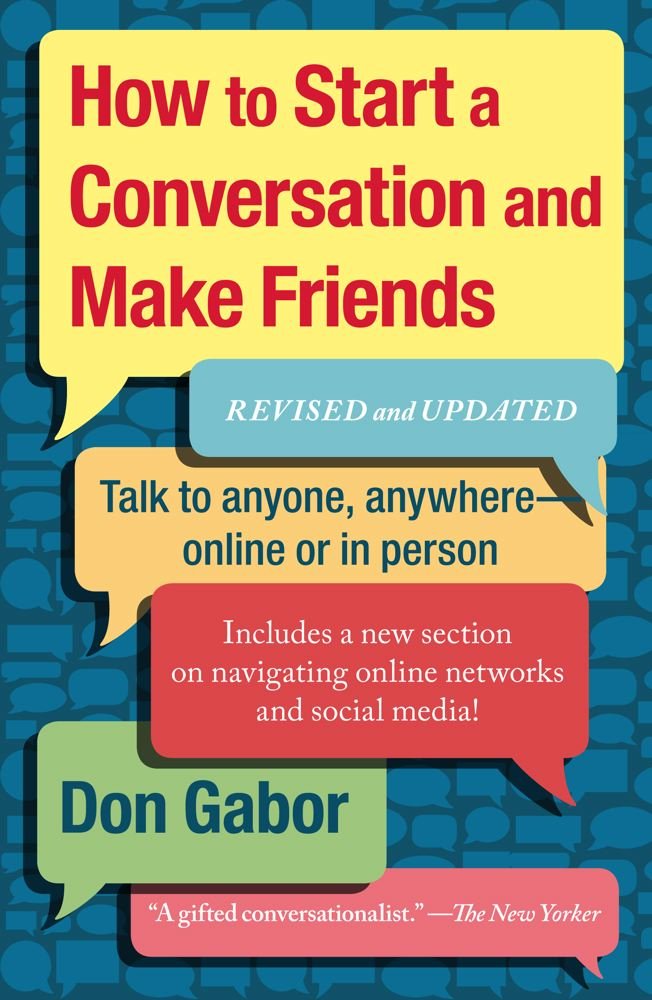How to Start a Conversation and Make Friends Summary
5 min read ⌚
 Talk to Anyone, Anywhere – Online or in Person
Talk to Anyone, Anywhere – Online or in Person
For some people, starting a conversation is the second most difficult thing on this planet; which is the reason why, to them, making a friend is the most difficult one.
Don Gabor, in “How to Start a Conversation and Make Friends” tries to help you with both.
Here’s how.
About Don Gabor
 Don Gabor is a communication expert and small talk specialist who has authored numerous books on these subjects, including “Speaking Your Mind in 101 Difficult Situations” and “Talking with Confidence for the Painfully Shy.”
Don Gabor is a communication expert and small talk specialist who has authored numerous books on these subjects, including “Speaking Your Mind in 101 Difficult Situations” and “Talking with Confidence for the Painfully Shy.”
Find out more at http://www.dongabor.com/
“How to Start a Conversation and Make Friends Summary”
Have you ever felt incapable of starting a conversation? Do you feel as if most of them look something like this, this or this?
Time to change that.
And the most important lesson you should learn is that all conversations begin before they actually begin. Just like there is such thing as pre-suasion, there is also such thing as pre-discussion.
And it’s wordless.
Or, in other words (that is not a pun, is it?) – it’s carried out through your body.
That’s right: body language is not something of note in business discussions only. It’s something important in everyday discussions as well.
Primarily, we must discover what do we first notice when we meet new people? Indeed, the body language has a significant role in improving or worsening the first impression. For instance, you might think that others involved in the conversation would appreciate your position and contribution, but if you cross your arms and avoid eye-contact, their opinion will change.
As you can see, body language is a crucial tool for making an impact. In general, there are all sorts of characters, but regardless of any other traits, one must be at least eager to improve its communication skills.
Some individuals are shy, and they need more time to adapt and fully engage in the discussion. No worries, even this shyness can be reduced with the help of several tricks. One of them is developing a routine to read the headlines of magazines and find something that matches your area of expertise each day.
If you don’t have a habit of starting a conversation, especially with people you don’t know personally, you must at least take an open stance, with a gentle smile on your face, that shows your openness. Let others approach you, but make sure you are ready for sharing your thoughts on the proposed topic.
Most people are more than happy to be a part of an interaction that corresponds to their interests. Engaging is much more natural in such conversations, and somehow it generates sincerity and openness among the interlocutors.
A great way to start is to ask them, what do they do? People are happy to share their success or complain about their present situation, concerning their professional life.
To subtly join a conversation that is currently unfolding, stand beside people with similar interest and show curiosity with an open body language. Somehow, you will be given access and even an incentive to share your viewpoints.
Asking questions when others are not speaking is also advisable.
If you are one of those, who have trouble remembering names, pay more attention to introductions. To improve your chances of getting the technique right, you can ask politely to repeat the previous sentence.
This one stands for: smile, open arms, forward lean, touch, eye contact, nod. Those are the body basics, and you should never forget about them (hence, the handy acronym)! For example, crossing subconsciously says that you’re self-protective. And people like to talk sincerely with sincere people.
Don’t you as well?
Now, it’s time for the conversation starters.
Ritual questions will always do the trick. Say, “How are you doing?” (though, not Joey-like: that’s reserved for other situations) or “Where do you work?”
After all, they haven’t turned into a ritual for anything. They’re not boring. They’re just ways to get into some other subjects.
And they will come out eventually! There are always “hot topics” which people are interested in talking about. Books, news, movies – you name it. Never forget: you probably know about them at least as much as the people you’re talking to.
And even more probably: they really want to hear your opinions.
One other thing they want as well: someone who cares and understands them. That’s why compliments will always get you far. Just as remembering and repeating names.
Why?
Because it shows that you’re listening. And that you’re really participating in the discussion.
Without an agenda, without some secret plan.
Key Lessons from “How to Start a Conversation and Make Friends”
1. SOFTEN Your Approach
2. Ritual Questions and “Hot Topics” Will Get Through the Awkward Parts
3. Adjust Your Conversation Style – and Then C-H-A-T Away
SOFTEN Your Approach
Never forget that your conversation starts well before the actual conversation. And in order to really control your body language, you need to SOFTEN your approach. In other words, you need to start smiling, while holding open arms, and forward lean.
Then, you need to try and touch the person you’re talking to (i.e., a handshake) while maintaining eye contact.
Finally, you need to nod in agreement with some of the things he or she is saying.
Ritual Questions and “Hot Topics” Will Get Through the Awkward Parts
To get the conversation going, start away by asking some of the more usual, ritual questions: “How are you,” “Where do you work?” etc. They will help you get to the “hot topics” parts. These are the subjects everybody wants to have a say in.
Think, for example, how flattered you’d be if someone asked you “What do you do for fun?” Well, the same holds true for everybody!
Adjust Your Conversation Style – and Then C-H-A-T Away
Not every person is the same. So, not everyone favors the same conversation style. In “How to Start a Conversation and Make Friends,” Gabor lists four different types.
You have the candid people, which are competitive and honest to the point of bragging. Then, there are the hang back people, which are good listeners and easy to talk to. The accurate ones talk about details and facts. Finally, the talkative want to be the star of the conversation.
Use this knowledge to adjust. And then – chat away!
Like this summary? We’d Like to invite you to download our free 12 min app, for more amazing summaries and audiobooks.
“How to Start a Conversation and Make Friends” Quotes
It has been said that a friend knows all about you but likes you anyway. For people to remain friends and friendships to grow requires flexibility and tolerance. Share on X People are not mind readers, and unless you tell or show them what you want, they just won’t know. Share on X Hot buttons are subjects that you or your conversational partner can really ‘get into’ and talk about for an extended period of time. Share on X If you don’t express preferences, tastes, wants and desires, people won’t know what you like or what you are seeking. Share on X Silence is natural in a conversation. Words don’t have to be spoken all the time to communicate. Share on X
Emir is the Head of Marketing at 12min. In his spare time, he loves to meditate and play soccer.


 Talk to Anyone, Anywhere – Online or in Person
Talk to Anyone, Anywhere – Online or in Person



